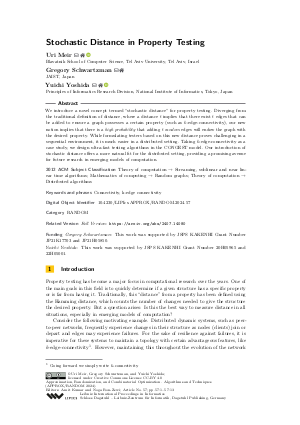Stochastic Distance in Property Testing
Authors
Uri Meir  ,
Gregory Schwartzman,
Yuichi Yoshida
,
Gregory Schwartzman,
Yuichi Yoshida 
-
Part of:
Volume:
Approximation, Randomization, and Combinatorial Optimization. Algorithms and Techniques (APPROX/RANDOM 2024)
Part of: Series: Leibniz International Proceedings in Informatics (LIPIcs)
Part of: Conference: International Conference on Approximation Algorithms for Combinatorial Optimization Problems (APPROX)
Part of: Conference: International Conference on Randomization and Computation (RANDOM) - License:
 Creative Commons Attribution 4.0 International license
Creative Commons Attribution 4.0 International license
- Publication Date: 2024-09-16
File

PDF
LIPIcs.APPROX-RANDOM.2024.57.pdf
- Filesize: 0.67 MB
- 13 pages
Document Identifiers
Related Versions
- Full Version https://arxiv.org/abs/2407.14080
Subject Classification
ACM Subject Classification
- Theory of computation → Streaming, sublinear and near linear time algorithms
- Mathematics of computing → Random graphs
- Theory of computation → Distributed algorithms
Keywords
- Connectivity
- k-edge connectivity
Metrics
- Access Statistics
-
Total Accesses (updated on a weekly basis)
0PDF Downloads0Metadata Views
Abstract
We introduce a novel concept termed "stochastic distance" for property testing. Diverging from the traditional definition of distance, where a distance t implies that there exist t edges that can be added to ensure a graph possesses a certain property (such as k-edge-connectivity), our new notion implies that there is a high probability that adding t random edges will endow the graph with the desired property. While formulating testers based on this new distance proves challenging in a sequential environment, it is much easier in a distributed setting. Taking k-edge-connectivity as a case study, we design ultra-fast testing algorithms in the CONGEST model. Our introduction of stochastic distance offers a more natural fit for the distributed setting, providing a promising avenue for future research in emerging models of computation.
Cite As Get BibTex
Uri Meir, Gregory Schwartzman, and Yuichi Yoshida. Stochastic Distance in Property Testing. In Approximation, Randomization, and Combinatorial Optimization. Algorithms and Techniques (APPROX/RANDOM 2024). Leibniz International Proceedings in Informatics (LIPIcs), Volume 317, pp. 57:1-57:13, Schloss Dagstuhl – Leibniz-Zentrum für Informatik (2024)
https://doi.org/10.4230/LIPIcs.APPROX/RANDOM.2024.57
BibTex
@InProceedings{meir_et_al:LIPIcs.APPROX/RANDOM.2024.57,
author = {Meir, Uri and Schwartzman, Gregory and Yoshida, Yuichi},
title = {{Stochastic Distance in Property Testing}},
booktitle = {Approximation, Randomization, and Combinatorial Optimization. Algorithms and Techniques (APPROX/RANDOM 2024)},
pages = {57:1--57:13},
series = {Leibniz International Proceedings in Informatics (LIPIcs)},
ISBN = {978-3-95977-348-5},
ISSN = {1868-8969},
year = {2024},
volume = {317},
editor = {Kumar, Amit and Ron-Zewi, Noga},
publisher = {Schloss Dagstuhl -- Leibniz-Zentrum f{\"u}r Informatik},
address = {Dagstuhl, Germany},
URL = {https://drops.dagstuhl.de/entities/document/10.4230/LIPIcs.APPROX/RANDOM.2024.57},
URN = {urn:nbn:de:0030-drops-210506},
doi = {10.4230/LIPIcs.APPROX/RANDOM.2024.57},
annote = {Keywords: Connectivity, k-edge connectivity}
}
Author Details
Funding
- Schwartzman, Gregory: This work was supported by JSPS KAKENHI Grant Number JP21K17703 and JP21H05850.
- Yoshida, Yuichi: This work was supported by JSPS KAKENHI Grant Number 20H05965 and 22H05001.
References
-
John Augustine, Anisur Rahaman Molla, Gopal Pandurangan, and Yadu Vasudev. Byzantine connectivity testing in the congested clique. In DISC, volume 246 of LIPIcs, pages 7:1-7:21. Schloss Dagstuhl - Leibniz-Zentrum für Informatik, 2022.

-
Marcel Bezdrighin, Michael Elkin, Mohsen Ghaffari, Christoph Grunau, Bernhard Haeupler, Saeed Ilchi, and Václav Rozhon. Deterministic distributed sparse and ultra-sparse spanners and connectivity certificates. In SPAA, pages 1-10. ACM, 2022.

-
Zvika Brakerski and Boaz Patt-Shamir. Distributed discovery of large near-cliques. Distributed Comput., 24(2):79-89, 2011.

-
Keren Censor-Hillel and Michal Dory. Fast distributed approximation for TAP and 2-edge-connectivity. Distributed Comput., 33(2):145-168, 2020.

-
Keren Censor-Hillel, Eldar Fischer, Gregory Schwartzman, and Yadu Vasudev. Fast distributed algorithms for testing graph properties. Distributed Comput., 32(1):41-57, 2019.

-
Mohit Daga, Monika Henzinger, Danupon Nanongkai, and Thatchaphol Saranurak. Distributed edge connectivity in sublinear time. In STOC, pages 343-354. ACM, 2019.

-
Michal Dory. Distributed approximation of minimum k-edge-connected spanning subgraphs. In PODC, pages 149-158. ACM, 2018.

-
Michal Dory and Mohsen Ghaffari. A nearly time-optimal distributed approximation of minimum cost k-edge-connected spanning subgraph. In SODA, pages 4296-4334. SIAM, 2023.

-
Guy Even, Orr Fischer, Pierre Fraigniaud, Tzlil Gonen, Reut Levi, Moti Medina, Pedro Montealegre, Dennis Olivetti, Rotem Oshman, Ivan Rapaport, and Ioan Todinca. Three notes on distributed property testing. In DISC, volume 91 of LIPIcs, pages 15:1-15:30. Schloss Dagstuhl - Leibniz-Zentrum für Informatik, 2017.

-
Hendrik Fichtenberger and Yadu Vasudev. A two-sided error distributed property tester for conductance. In MFCS, volume 117 of LIPIcs, pages 19:1-19:15. Schloss Dagstuhl - Leibniz-Zentrum für Informatik, 2018.

-
Pierre Fraigniaud, Magnús M. Halldórsson, and Alexandre Nolin. Distributed testing of distance-k colorings. In SIROCCO, volume 12156 of Lecture Notes in Computer Science, pages 275-290. Springer, 2020.

-
Pierre Fraigniaud, Ivan Rapaport, Ville Salo, and Ioan Todinca. Distributed testing of excluded subgraphs. In DISC, volume 9888 of Lecture Notes in Computer Science, pages 342-356. Springer, 2016.

-
Oded Goldreich and Dana Ron. Property testing in bounded degree graphs. Algorithmica, 32(2):302-343, 2002.

-
Hiro Ito, Shin-Ichi Tanigawa, and Yuichi Yoshida. Constant-time algorithms for sparsity matroids. In International Colloquium on Automata, Languages, and Programming, pages 498-509. Springer, 2012.

-
David R. Karger. Global min-cuts in rnc, and other ramifications of a simple min-cut algorithm. In SODA, pages 21-30. ACM/SIAM, 1993.

-
Reut Levi, Moti Medina, and Dana Ron. Property testing of planarity in the CONGEST model. Distributed Comput., 34(1):15-32, 2021.

-
Y Orenstein. Testing properties of directed graphs. Master’s thesis, School of Electrical Engineering, 2010.

-
Merav Parter. Small cuts and connectivity certificates: A fault tolerant approach. In DISC, volume 146 of LIPIcs, pages 30:1-30:16. Schloss Dagstuhl - Leibniz-Zentrum für Informatik, 2019.

-
Shin-Ichi Tanigawa and Yuichi Yoshida. Testing the supermodular-cut condition. Algorithmica, 71(4):1065-1075, 2015.

-
Ramakrishna Thurimella. Sub-linear distributed algorithms for sparse certificates and biconnected components. J. Algorithms, 23(1):160-179, 1997.

-
Yuichi Yoshida and Hiro Ito. Testing k-edge-connectivity of digraphs. Journal of systems science and complexity, 23:91-101, 2010.

-
Yuichi Yoshida and Hiro Ito. Property testing on k-vertex-connectivity of graphs. Algorithmica, 62(3-4):701-712, 2012.

